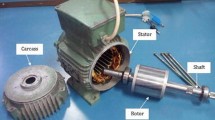Abstract
The wireless communication for rotating electrical machines is beneficial for diagnosis purposes as well as real-time monitoring. The electromagnetic waves propagation characteristics inside electrical machine is rather delicate. So it will be interesting to find a dynamic tool adapted to our problem. The idea is to validate these propagation concepts with real signatures. The tool must then analyze the signatures of the received signal strength indication. These experiments have shown that the antenna rotation is a disturbance-causing factor of the signal transmission. Thus, in this paper, our aim is to analyze the electromagnetic wave propagation characteristics in rotating environments in order to obtain the optimum parameters and providing a strong theoretical support for radio monitoring system performance improvement. Therefore, our work will process the important parameter which is the path loss variation in rotating environments.



















Similar content being viewed by others
References
Tavner PJ (2008) Review of condition monitoring of rotating electrical machines. IET Electr Power Appl 2(4):215–247
Habetler TG, Harley RG, Tallam RM, Lee SB, Obaid R, Stack J (2002) Complete current-based induction motor condition monitoring: stator, rotor, bearings, and load. In: 8th IEEE international power electronics congress CIEP
Tashakori A, Ektesabi M (2013) A simple fault tolerant control system for Hall effect sensors failure of BLDC motor. In: 8th IEEE conference on industrial electronics and applications (ICIEA)
Ben Brahim S, Bouallegue R, David J, Vuong TH (2015) Wireless communication to monitor the rotating electrical machines. In: 23rd international conference on software telecommunications and computer networks (SoftCOM)
Ben Brahim S, Bouallegue R, David J, Vuong TH, David M (2016) A wireless on-line temperature monitoring system for rotating electrical machine. Wirel Pers Commun 95(2):979–999
Ben Brahim S, Bouallegue R, David J, Vuong TH, David M (2016) Design and implementation of wireless sensor network node for rotating electrical machine. In: The twenty-first IEEE symposium on computers and communications (ISCC)
Cheikh-Mhand (2010) Design and Etude du canal de propagation radio pour les systèmes embarqués sans fil automobile. Ph.D. Thesis, Institut National Polytechnique de Toulouse-INPT
Nader M, Jawhar I (2008) A fault tolerant wired/wireless sensor network architecture for monitoring pipeline infrastructures. In: International conference on sensor technologies and applications (SENSORCOMM’08)
Henao H, Capolino G-A, Fernandez-Cabanas M, Filippetti F, Bruzzese C, Strangas E, Pusca R, Estima J, Riera-Guasp M, Hedayati-Kia S (2014) Trends in fault diagnosis for electrical machines: a review of diagnostic techniques. IEEE Ind Electron Mag 8:31–42
Hubert CI (1990) Electric machines. Prentice Hall
Cupertino F, Vanna E, Salvatore L, Stasi S (2004) Analysis techniques for detection of induction motor broken rotor bars after supply disconnection. IEEE Trans Ind Appl 40(2):526–533
Aileen J, Nagarajan S, Rama Reddy S (2011) Detection of broken bars in three phase squirrel cage induction motor using finite element method. In: International conference on emerging trends in electrical and computer technology (ICETECT)
Zaabi W, Bensalem Y, Trabelsi H (2014) Fault analysis of induction machine using Finite Element Method (FEM). In: 15th international conference on sciences and techniques of automatic control and computer engineering (STA)
Pande DC (1999) Electromagnetic compatibility problems in mobile communication systems. In: International conference on electromagnetic interference and compatibility (1999)
Shapira J (2011) Electromagnetic compatibility for system engineers. IETE Tech Rev 28:70–77
Mathur M, Rai JK, Sridhar N (2016) Electromagnetic compatibility analysis of projected capacitive touch technology based panel computer for military application. J Electromagn Waves Appl 30(13):1689–1701
Ben Brahim S, Bouallegue R, David J, Vuong TH, David M (2016) Modelling and characterization of rotor temperature monitoring system. In: 12th international conference on wireless communications and mobile computing conference (IWCMC)
Akeyama A, Sakagami S, Yosizawa K (1990) Propagation characteristics of air-ground propagation paths, 900MHz band. IEEE Trans IEICE Jpn J73–B–11:838–842
Hata M (1980) Empirical formula for propagation loss in land mobile radio service. IEEE Trans Veh Technol VT–29:317–325
Ben Brahim S, Bouallegue R, David J, Vuong TH (2015) Electromagnetic wave propagation characteristics of rotating antenna in electrical machine. In: 11th international conference on wireless communication and mobile computing (WiCOM) (2015)
Ben Brahim S, Bouallegue R, David J, Vuong TH (2016) Path-loss characteristics for wireless communication system in rotating electrical machine. In: 11th international conference on wireless communication and mobile computing (AINA) (2016)
Sinan K, Bulent T (2017) Path-loss modeling for wireless sensor networks: a review of models and comparative evaluations. IEEE Antennas Propag Mag 59:18–37
Xu J, Yan X, Zhu Y, Wang J, Yang Y, Ge X, Mao G, Tirkkonen O (2017) Statistical analysis of path losses for sectorized wireless networks. IEEE Trans Commun 65(4):1828–1838
Microchip. RN-171 Data Sheet (2014)
Microchip. RN-171-EK Data Sheet (2014)
Sommer C, Joerer S, Dressler F (2012) On the applicability of two-ray path loss models for vehicular network simulation. In: Vehicular networking conference (VNC). IEEE, pp 64–69 (2012)
Leng Y, Pan YF, Li QX, Liu S (2008) Analysis of electromagnetic wave propagation characteristics in rotating environment. In: Proceedings of ICEPTHDP international conference, pp 1–7
Kong JA (2002) Electromagnetic wave theory. Higher Education Press, Beijing, pp 889–903
Leng Y, Dong W, Peng S, Ge X, Nga GJ, Sheng L (2012) Study on electromagnetic wave propagation characteristics in rotating environments and its application in tire pressure monitoring. IEEE Trans Instrum Meas 61:1765–1777
Rappaport TS (2004) Wireless communications: principles and practice, 2nd edn. Publishing House of Electronics Industry, Beijing (ch. 3)
Acknowledgements
This work was supported in part by the Innov’COM Laboratory of Higher School of Telecommunication, University of Carthage, Tunisia, and LAPLACE Laboratory of the National Polytechnic Institute of Toulouse, France.
Author information
Authors and Affiliations
Corresponding author
Additional information
Publisher's Note
Springer Nature remains neutral with regard to jurisdictional claims in published maps and institutional affiliations.
Rights and permissions
About this article
Cite this article
Ben Brahim, S., Bouallegue, R., David, J. et al. Study and improvement in the radio communication quality for rotating electrical machine. Electr Eng 101, 855–865 (2019). https://doi.org/10.1007/s00202-019-00826-5
Received:
Accepted:
Published:
Issue Date:
DOI: https://doi.org/10.1007/s00202-019-00826-5



